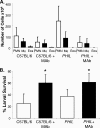Major basic protein from eosinophils and myeloperoxidase from neutrophils are required for protective immunity to Strongyloides stercoralis in mice
- PMID: 21482685
- PMCID: PMC3191984
- DOI: 10.1128/IAI.00931-10
Major basic protein from eosinophils and myeloperoxidase from neutrophils are required for protective immunity to Strongyloides stercoralis in mice
Abstract
Eosinophils and neutrophils contribute to larval killing during the primary immune response, and neutrophils are effector cells in the secondary response to Strongyloides stercoralis in mice. The objective of this study was to determine the molecular mechanisms used by eosinophils and neutrophils to control infections with S. stercoralis. Using mice deficient in the eosinophil granule products major basic protein (MBP) and eosinophil peroxidase (EPO), it was determined that eosinophils kill the larvae through an MBP-dependent mechanism in the primary immune response if other effector cells are absent. Infecting PHIL mice, which are eosinophil deficient, with S. stercoralis resulted in development of primary and secondary immune responses that were similar to those of wild-type mice, suggesting that eosinophils are not an absolute requirement for larval killing or development of secondary immunity. Treating PHIL mice with a neutrophil-depleting antibody resulted in a significant impairment in larval killing. Naïve and immunized mice with neutrophils deficient in myeloperoxidase (MPO) infected with S. stercoralis had significantly decreased larval killing. It was concluded that there is redundancy in the primary immune response, with eosinophils killing the larvae through an MBP-dependent mechanism and neutrophils killing the worms through an MPO-dependent mechanism. Eosinophils are not required for the development or function of secondary immunity, but MPO from neutrophils is required for protective secondary immunity.
Figures





Similar articles
-
Role of eosinophils and neutrophils in innate and adaptive protective immunity to larval strongyloides stercoralis in mice.Infect Immun. 2006 Oct;74(10):5730-8. doi: 10.1128/IAI.01958-05. Infect Immun. 2006. PMID: 16988250 Free PMC article.
-
Strongyloides stercoralis: eosinophil-dependent immune-mediated killing of third stage larvae in BALB/cByJ mice.Exp Parasitol. 1996 Apr;82(3):267-78. doi: 10.1006/expr.1996.0034. Exp Parasitol. 1996. PMID: 8631378
-
Role of IL-5 in innate and adaptive immunity to larval Strongyloides stercoralis in mice.J Immunol. 2000 Oct 15;165(8):4544-51. doi: 10.4049/jimmunol.165.8.4544. J Immunol. 2000. PMID: 11035095
-
Innate and adaptive immunity to the nematode Strongyloides stercoralis in a mouse model.Immunol Res. 2011 Dec;51(2-3):205-14. doi: 10.1007/s12026-011-8258-2. Immunol Res. 2011. PMID: 22101674 Free PMC article. Review.
-
Eosinophil granule proteins: form and function.J Biol Chem. 2014 Jun 20;289(25):17406-15. doi: 10.1074/jbc.R113.546218. Epub 2014 May 6. J Biol Chem. 2014. PMID: 24802755 Free PMC article. Review.
Cited by
-
Living without eosinophils: evidence from mouse and man.Eur Respir J. 2023 Jan 12;61(1):2201217. doi: 10.1183/13993003.01217-2022. Print 2023 Jan. Eur Respir J. 2023. PMID: 35953100 Free PMC article. Review.
-
Deletion of parasite immune modulatory sequences combined with immune activating signals enhances vaccine mediated protection against filarial nematodes.PLoS Negl Trop Dis. 2012;6(12):e1968. doi: 10.1371/journal.pntd.0001968. Epub 2012 Dec 27. PLoS Negl Trop Dis. 2012. PMID: 23301106 Free PMC article.
-
Chitinase-like proteins promote IL-17-mediated neutrophilia in a tradeoff between nematode killing and host damage.Nat Immunol. 2014 Dec;15(12):1116-25. doi: 10.1038/ni.3023. Epub 2014 Oct 19. Nat Immunol. 2014. PMID: 25326751 Free PMC article.
-
Eosinophils mediate protective immunity against secondary nematode infection.J Immunol. 2015 Jan 1;194(1):283-90. doi: 10.4049/jimmunol.1402219. Epub 2014 Nov 26. J Immunol. 2015. PMID: 25429065 Free PMC article.
-
Eosinophils and helminth infection: protective or pathogenic?Semin Immunopathol. 2021 Jun;43(3):363-381. doi: 10.1007/s00281-021-00870-z. Epub 2021 Jun 24. Semin Immunopathol. 2021. PMID: 34165616 Review.
References
-
- Abraham D., et al. 1995. Strongyloides stercoralis: protective immunity to third-stage larvae in BALB/cByJ mice. Exp. Parasitol. 80:297–307 - PubMed
-
- Ackerman S. J., Gleich G. J., Loegering D. A., Richardson B. A., Butterworth A. E. 1985. Comparative toxicity of purified human eosinophil granule cationic proteins for schistosomula of Schistosoma mansoni. Am. J. Trop. Med. Hyg. 34:735–745 - PubMed
Publication types
MeSH terms
Substances
Grants and funding
LinkOut - more resources
Full Text Sources
Molecular Biology Databases
Research Materials
Miscellaneous

